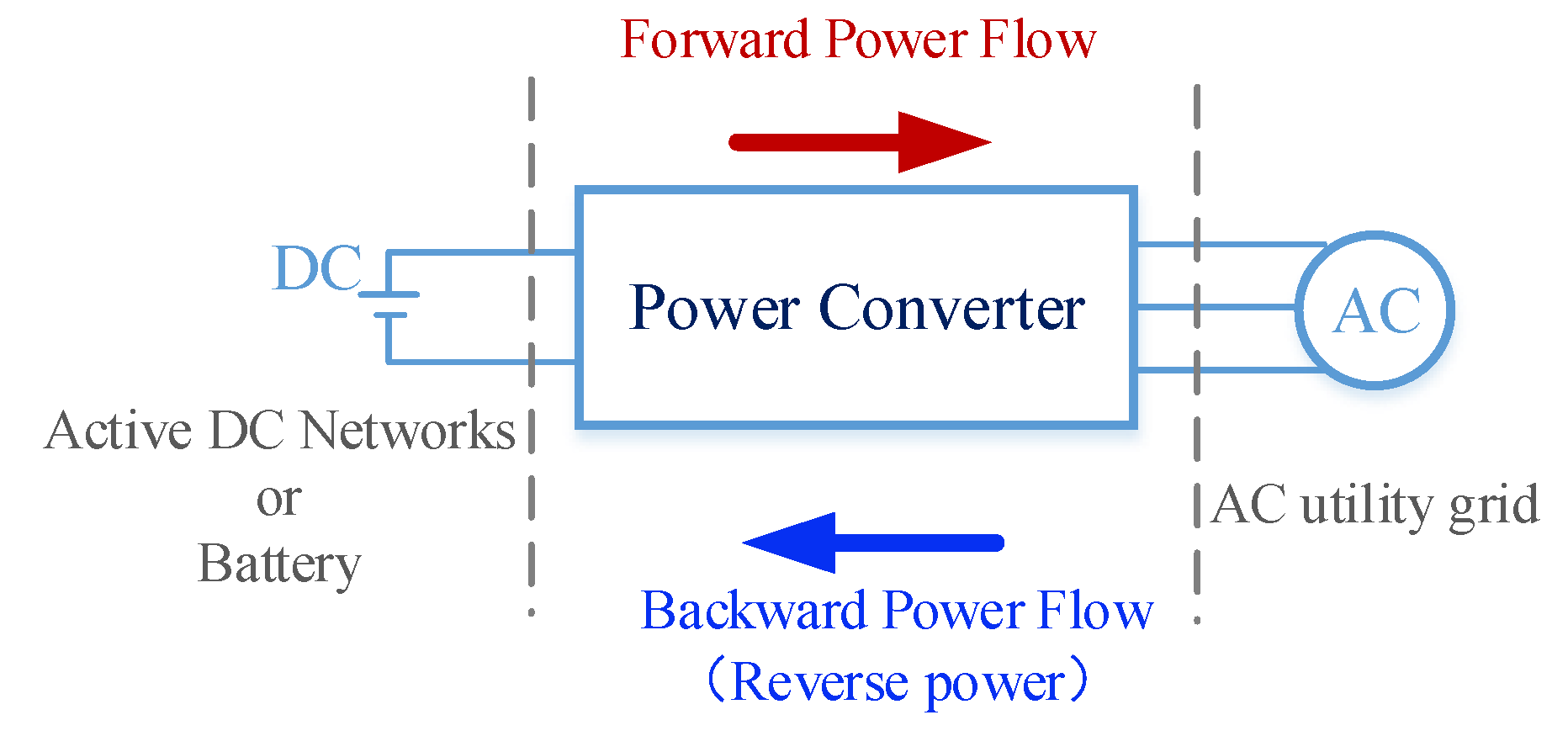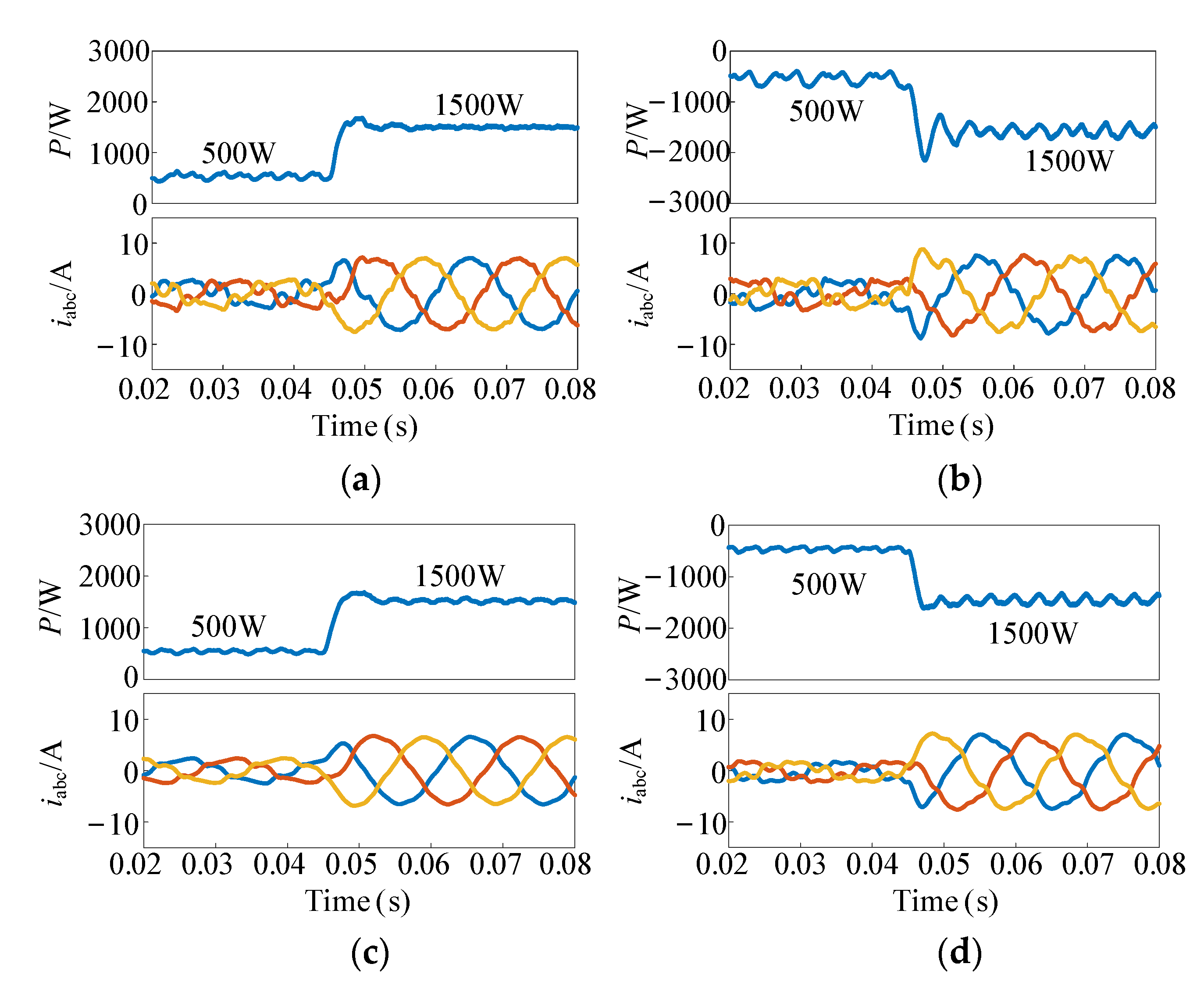Dynamic Grid Voltage-Based Impedance-Reshaped Control for the Stability Enhancement of Grid-Connected DC/AC Converter System under Bidirectional Power Flow
Abstract
1. Introduction
2. Impedance Modeling and Stability Analysis of Grid-Connected DC/AC Converter System under Conventional Control
2.1. Topology and Control of Grid-Connected Converter System
2.2. Impedance Modeling of Grid-Connected Converter under Conventional Control
2.3. Impedance Interaction with Conventional Direct Power Control
3. Impedance-Reshaped Stability-Enhancing Control
3.1. Impedance-Reshaped Stability-Enhancing Control
3.2. Impedance Modelling with Proposed Control
3.3. Impedance Interaction with the Proposed Control
3.4. The Influence of Voltage Reduction on the System Stability
4. Simulation and Experiment Results
4.1. Simulation Results
4.2. Experimental Results
5. Conclusions
Author Contributions
Funding
Institutional Review Board Statement
Informed Consent Statement
Conflicts of Interest
References
- Loh, P.C.; Li, D.; Chai, Y.K.; Blaabjerg, F. Hybrid AC-DC microgrids with energy storages and progressive energy flow tuning. IEEE Trans. Power Electron. 2013, 28, 1533–1542. [Google Scholar] [CrossRef]
- Blaabjerg, F.; Teodorescu, R.; Liserre, M.; Timbus, A.V. Overview of control and grid synchronization for distributed power generation systems. IEEE Trans. Ind. Electron. 2006, 53, 1398–1409. [Google Scholar] [CrossRef]
- Tang, C.; Chen, Y.; Chen, Y.; Chang, Y. DC-link voltage control strategy for three-phase back-to-back active power conditioners. IEEE Trans. Power Electron. 2015, 62, 6306–6316. [Google Scholar] [CrossRef]
- Yang, L.; Chen, Y.; Luo, A.; Chen, Z.; Zhou, L.; Zhou, X.; Wu, W.; Tan, W.; Guerrero, J.M. Effect of phase-locked loop on small-signal perturbation modelling and stability analysis for three-phase LCL-type inverter connected to weak grid. IET Renew. Power Gener. 2020, 13, 86–93. [Google Scholar] [CrossRef]
- Tian, Y.; Chen, Z.; Deng, F.; Sun, X.; Hu, Y. Active power and DC voltage coordinative control for cascaded DC-AC converter with bidirectional application. IEEE Trans. Power Electron. 2015, 30, 5911–5925. [Google Scholar] [CrossRef]
- Sun, J. Small-signal methods for AC distributed power system—A review. IEEE Trans. Power Electron. 2009, 24, 2545–2554. [Google Scholar]
- Tian, Y.; Loh, P.C.; Chen, Z.; Deng, F.; Hu, Y. Impedance interactions in bidirectional cascaded converter. IET Power Electron. 2016, 9, 2842–2891. [Google Scholar] [CrossRef]
- Liu, H.; Xie, X.; He, J.; Xu, T.; Yu, Z.; Wang, C.; Zhang, C. Subsynchronous interaction between direct-drive PMSG based wind farms and weak AC networks. IEEE Trans. Power Syst. 2017, 32, 4708–4720. [Google Scholar] [CrossRef]
- Zhang, X.; Xia, D.; Fu, Z.; Wang, G.; Xu, D. An improved Feedforward control method considering PLL dynamics to improved weak grid stability of grid-connected inverters. IEEE Trans. Ind. Appl. 2018, 54, 5143–5151. [Google Scholar] [CrossRef]
- Shuai, Z.; Li, Y.; Wu, W.; Tu, C.; Luo, A.; Shen, Z. Divided dq small-signal model: A new perspective for the stability analysis of three-phase grid-tied inverters. IEEE Trans. Ind. Electron. 2020, 66, 6493–6504. [Google Scholar] [CrossRef]
- Wen, B.; Boroyevich, D.; Burgos, R.; Mattavelli, P.; Shen, Z. Analysis of D-Q small-signal impedance of grid-tied inverters. IEEE Trans. Power Electron. 2016, 31, 675–687. [Google Scholar] [CrossRef]
- Khaligh, E.A.; Rivetta, C.H.; Williamson, G.A. Constant power loads and negative impedance instability in automotive systems: Definition, modeling, stability, and control of power electronic converters and motor drives. IEEE Trans. Veh Technol. 2006, 55, 1112–1125. [Google Scholar]
- Tian, Y.; Loh, P.C.; Deng, F.; Chen, Z.; Sun, X.; Hu, Y. Impedance coordinative control for cascaded converter in bidirectional application. IEEE Trans. Ind. Appl. 2016, 52, 4084–4095. [Google Scholar] [CrossRef]
- Wu, W.; Chen, Y.; Zhou, L.; Zhou, X.; Yang, L.; Dong, Y.; Xie, Z.; Luo, A. A virtual phase-lead impedance stability control strategy for the maritime VSC–HVDC system. IEEE Trans. Ind. Informat. 2018, 14, 5475–5486. [Google Scholar] [CrossRef]
- Tian, Y.; Liu, T.; Wang, Y.; Yang, D.; Hao, Y.; Chen, Z. Virtual Impedance Refined Inductor Current Observation and Current Sensorless Control for Grid-Connected Inverter. IEEE Trans. Power Electron. 2022, 37, 10239–10249. [Google Scholar] [CrossRef]
- Huai, Q. A Virtual Impedance Control Strategy for Improving the Stability and Dynamic Performance of VSC–HVDC Operation in Bidirectional Power Flow Mode. Appl. Sci. 2020, 9, 3184. [Google Scholar]
- Huang, X.; He, Z.; Chen, Z.; Liu, Y.; Wu, W.; Xu, Q.; Zhou, L.; Luo, A. Stability assessment and coordinated impedance shaping strategy for DC bidirectional cascaded system with LC input filter. Int. J. Electr. Power Energy Syst. 2020, 115, 105429. [Google Scholar] [CrossRef]
- Harnefors, L.; Bongiorno, M.; Lundberg, S. Imput-admittance calculation and shaping for controlled voltage-source converters. IEEE Trans. Ind. Electron. 2007, 54, 3323–3334. [Google Scholar] [CrossRef]
- Fang, J.; Li, X.; Li, H.; Tang, Y. Stability Improvement for Three-Phase Grid-Connected Converters through Impedance Reshaping in Quadrature-Axis. IEEE Trans. Power Electron. 2018, 33, 8365–8375. [Google Scholar] [CrossRef]
- Li, Y.; Shuai, Z.; Liu, X.; Hong, Y.; Wu, X.; Shen, Z.J. Stability Investigation of Bidirectional AC-DC Converter Considering Operating Conditions. IEEE Access 2020, 8, 131499–131510. [Google Scholar] [CrossRef]
- Wen, B.; Boroyevich, D.; Burgos, R.; Mattavelli, P.; Shen, Z. Small-signal stability analysis of three-phase AC systems in the presence of constant power loads based on measured d-q frame impedances. IEEE Trans. Power Electron. 2015, 30, 5952–5963. [Google Scholar] [CrossRef]
- Cespedes, M.; Xing, L.; Sun, J. Constant-power load system stabilization by passive damping. IEEE Trans. Power Electron. 2011, 26, 1832–1836. [Google Scholar] [CrossRef]
- Burgos, R.; Boroyevich, D.; Wang, F.; Karimi, K.; Francis, G. On the ac stability of high power factor three-phase rectifiers. In Proceedings of the 2010 IEEE Energy Conversion Congress and Exposition, Atlanta, GA, USA, 12–16 September 2010; pp. 2047–2054. [Google Scholar]
- Wen, B.; Burgos, R.; Boroyevich, D.; Mattavelli, P.; Shen, Z. AC stability analysis and dq impedance specification in power electronics based distributed power systems. IEEE J. Emerg. Select. Top. Power Electron. 2017, 5, 1455–1465. [Google Scholar] [CrossRef]
- Du, Y.; Cui, L.; Yang, X.; Su, J.; Wang, F. Impedance-phase reshaping of LCL-filtered grid-connected inverter to improve the stability in a weak grid. In Proceedings of the 2017 IEEE Energy Conversion Congress and Exposition (ECCE), Cincinnati, OH, USA, 1–5 November 2017; pp. 2921–2926. [Google Scholar]
- Wen, B.; Dong, D.; Boroyevich, D.; Burgos, R.; Mattavelli, P.; Shen, Z. Impedance-based analysis of grid-synchronization stability for three-phase paralleled converters. IEEE Trans. Power Electron. 2016, 31, 26–38. [Google Scholar] [CrossRef]
- Leppaaho, J.; Huusari, J.; Nousiainen, L.; Puukko, J.; Suntio, T. Dynamic properties and stability assessment of current-fed converters in photovoltaic applications. IEEE Trans Ind. Appl. 2011, 131, 976–984. [Google Scholar] [CrossRef]
- Wildrick, M.; Lee, F.C.; Cho, B.H.; Choi, B. A method of defining the load impedance specification for a stable distributed power system. IEEE Trans. Power Electron. 1995, 10, 280–285. [Google Scholar] [CrossRef]
- Yang, D.; Ruan, X.; Wu, H. Impedance Shaping of the Grid-Connected Inverter with LCL Filter to Improve Its Adaptability to the Weak Grid Condition. IEEE Trans. Power Electron. 2014, 29, 5795–5805. [Google Scholar] [CrossRef]






















| Parameter | Value |
|---|---|
| Udc | 400 V |
| ωg | 2π × 50 rad/s |
| fsw | 10 kHz |
| C | 400 uF |
| Lf | 3 mH |
| Rf | 0.1 Ω |
| Lg | 1 mH |
| Rg | 0.1 Ω |
Publisher’s Note: MDPI stays neutral with regard to jurisdictional claims in published maps and institutional affiliations. |
© 2022 by the authors. Licensee MDPI, Basel, Switzerland. This article is an open access article distributed under the terms and conditions of the Creative Commons Attribution (CC BY) license (https://creativecommons.org/licenses/by/4.0/).
Share and Cite
Liu, L.; Wang, K.; Peng, F.; Tian, Y.; Wang, Y. Dynamic Grid Voltage-Based Impedance-Reshaped Control for the Stability Enhancement of Grid-Connected DC/AC Converter System under Bidirectional Power Flow. Energies 2022, 15, 7269. https://doi.org/10.3390/en15197269
Liu L, Wang K, Peng F, Tian Y, Wang Y. Dynamic Grid Voltage-Based Impedance-Reshaped Control for the Stability Enhancement of Grid-Connected DC/AC Converter System under Bidirectional Power Flow. Energies. 2022; 15(19):7269. https://doi.org/10.3390/en15197269
Chicago/Turabian StyleLiu, Li, Kun Wang, Fei Peng, Yanjun Tian, and Yi Wang. 2022. "Dynamic Grid Voltage-Based Impedance-Reshaped Control for the Stability Enhancement of Grid-Connected DC/AC Converter System under Bidirectional Power Flow" Energies 15, no. 19: 7269. https://doi.org/10.3390/en15197269
APA StyleLiu, L., Wang, K., Peng, F., Tian, Y., & Wang, Y. (2022). Dynamic Grid Voltage-Based Impedance-Reshaped Control for the Stability Enhancement of Grid-Connected DC/AC Converter System under Bidirectional Power Flow. Energies, 15(19), 7269. https://doi.org/10.3390/en15197269








